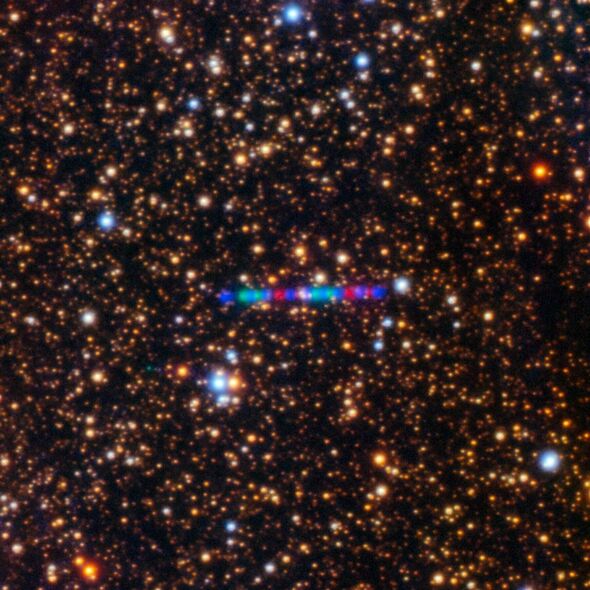Science
Congresswoman Demands NASA Release Data on Accelerating 3I/ATLAS

A growing sense of urgency surrounds the interstellar object 3I/ATLAS, which has reportedly accelerated as it approaches Earth. In response to these developments, Republican Congresswoman Anna Paulina Luna from Florida has called on NASA to release crucial data and images related to the object. Luna’s request aims to enhance public understanding of what she describes as “interstellar visitors.”
In a post on X, Luna stated, “I write to request the release of specific observational data related to 3I/ATLAS, recently captured by NASA missions. This information is of great importance to advancing our understanding of interstellar visitors and their interaction with our solar system.” She specifically highlighted the need for images taken by the HiRISE camera aboard the Mars Reconnaissance Orbiter between October 2 and 3. In addition, she requested supplementary data from the Mars Orbiter, the Perseverance Rover, and other missions that may have detected unusual activity near Mars around or after October 3, 2025, when 3I/ATLAS passed within approximately 30 million kilometers (18.6 million miles) of the planet.
This demand follows reports that 3I/ATLAS has “unexpectedly picked up speed,” accelerating from 130,000 mph to 152,000 mph. Scientists have observed an “extra kick” propelling the 12-mile-wide object off its anticipated trajectory, a deviation that cannot be explained solely by the sun’s gravitational influence. The sun, which holds the majority of the solar system’s mass, exerts a gravitational pull that keeps celestial bodies in a predictable motion. Nonetheless, the recent behavior of 3I/ATLAS raises questions about our current understanding of gravitational forces.
While NASA attributes the increase in speed primarily to solar gravity, researchers are grappling with the cause of 3I/ATLAS’s notable deviation from its expected path. Most experts believe that the object is a comet that has traveled from another star system to the sun over billions of years. Yet, Avi Loeb, a theoretical physicist, has proposed an alternative theory. He suggests that the object may be an “extraterrestrial artifact” poised for potential contact.
Loeb argues that the object’s rapid acceleration and distinctive blue color could indicate an artificial origin. If 3I/ATLAS were a typical comet, the heat from the sun would likely cause it to release gas jets, which could alter its trajectory. However, the physicist notes that astronomers have yet to observe sufficient gas emissions from 3I/ATLAS to confirm its classification as a comet.
With just six weeks remaining until the object reaches its closest point to Earth, Loeb posits that if no gas cloud is detected emanating from 3I/ATLAS, it could suggest that the recent speed increase is fueled by an extraterrestrial rocket engine.
The situation continues to evolve, and as 3I/ATLAS approaches, the call for transparency from NASA is likely to gain momentum. Congresswoman Luna’s request emphasizes the public’s interest in understanding the complexities of interstellar travel and the nature of objects visiting our solar system.
-

 Science3 weeks ago
Science3 weeks agoInterstellar Object 3I/ATLAS Emits Unique Metal Alloy, Says Scientist
-

 Science3 weeks ago
Science3 weeks agoResearchers Achieve Fastest Genome Sequencing in Under Four Hours
-

 Politics3 weeks ago
Politics3 weeks agoAfghan Refugee Detained by ICE After Asylum Hearing in New York
-

 Business3 weeks ago
Business3 weeks agoIconic Sand Dollar Social Club Listed for $3 Million in Folly Beach
-

 Health3 weeks ago
Health3 weeks agoPeptilogics Secures $78 Million to Combat Prosthetic Joint Infections
-

 Lifestyle3 weeks ago
Lifestyle3 weeks agoJump for Good: San Clemente Pier Fundraiser Allows Legal Leaps
-

 Science3 weeks ago
Science3 weeks agoMars Observed: Detailed Imaging Reveals Dust Avalanche Dynamics
-

 Business3 weeks ago
Business3 weeks agoMcEwen Inc. Secures Tartan Lake Gold Mine Through Acquisition
-

 World3 weeks ago
World3 weeks agoUS Passport Ranks Drop Out of Top 10 for First Time Ever
-

 Health3 weeks ago
Health3 weeks agoResearcher Uncovers Zika Virus Pathway to Placenta Using Nanotubes
-

 Entertainment3 weeks ago
Entertainment3 weeks agoJennifer Lopez Addresses A-Rod Split in Candid Interview
-

 Business3 weeks ago
Business3 weeks agoSan Jose High-Rise Faces Foreclosure Over $182.5 Million Loan









